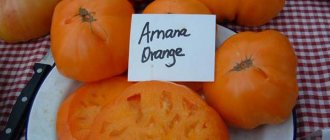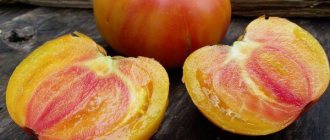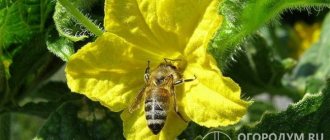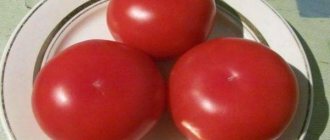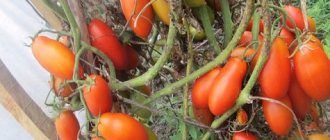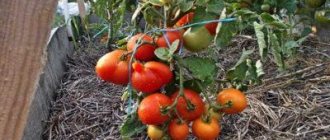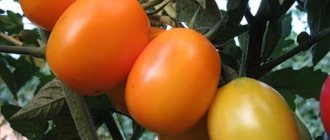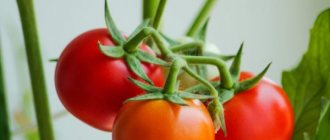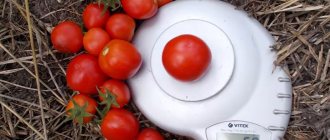Description of the variety
Fruit:
- Flat-round shape;
- With a characteristic orange-yellow color;
- With thin skin;
- With fleshy, juicy pulp, an unforgettable sugary taste and pleasant aroma;
- With a small number of seed chambers;
The average weight varies from 300 to 450 grams.
- Dry matter content is average;
- Large sizes.
Bushes:
- Indeterminate, non-standard plant;
- Medium-sized, reaches a height of up to 150 cm;
- Leaves are medium sized, green in color;
- The inflorescence is simple;
- Pedicel with articulation.
Description of hybrid No. XII from the “King of the Market” series
Most hybrids are created to develop certain qualities in the plant that are most in demand among the consumer. This is primarily productivity, the ability to resist diseases characteristic of the species, and resistance to extremes of high or low temperatures.
These qualities are often considered mandatory for hybrid varieties. With the advent of such advantages, most greenhouse farms use only hybrid seeds for vegetable production. It is believed that ordinary varietal plants are not able to resist pathogenic microflora formed in the closed conditions of film and glass greenhouses.
- Market King hybrids are no exception. “Honey King” refers to indeterminate, tall varieties that are adapted for cultivation in greenhouse conditions. But in regions with a sufficiently long summer period, it can be cultivated in the open air, but with the obligatory strengthening of the main stem to a reliable support.
- The plant is well leafy and grows up to 2 meters during the growing season. In greenhouses it is attached to trellises or tied. Agricultural cultivation techniques do not differ from the rules for caring for tall tomatoes. They boil down to moderate watering, timely fertilizing, shaping the bush in height and removing excess side shoots.
- Fruits with excellent commercial characteristics deserve special attention. They have a round, even shape. The skin is strong, smooth, red with a raspberry tint. The weight, adjusted to the shape and size of the fruit, ranges from 180 to 220 g.
- The tomatoes resemble salad, pink-fruited varieties. The tomato pulp is juicy, but quite dense. The taste is sweet, pleasant, reminiscent of sweet cherry varieties in terms of sugar content. The fruits are universally used, store well and are not afraid of transportation.
See also
Description and characteristics of the tomato variety Pink SolutionRead
Of the entire series, this is the sweetest and most pleasant-tasting tomato, the king in the “Kings of the Market” category. If you add the other advantages of hybrids to the excellent taste, then this variety will certainly find fans not only among farmers, but also among amateur vegetable growers. After all, few will object to the truth that there is never too much of a good thing. The higher the harvest of delicious tomatoes, the better.
Growing tomatoes
The tomato variety “Honey King” is grown in seedlings.
How to prepare seeds?
Recommendations for preparing seed material:
- Seeds are calibrated before sowing, selecting only high-quality specimens;
- Then the disinfection procedure begins. To do this, the seeds are soaked in a weak solution of manganese for 20-30 minutes. Afterwards, rinse thoroughly under running water and leave to dry;
- Then they are treated in any growth stimulant, leaving the seeds in the solution for 10-12 hours;
- Seed material needs to be germinated. For this purpose, it is placed on a damp cloth and wrapped in a plastic bag. The bundle is placed in a warm place until the sprouts hatch, this usually takes from 3 to 5 days.
IMPORTANT: Once a day, remove the seeds from the bag for 30 minutes.
Sowing seed material
How to sow seeds for seedlings:
- Seed material is sown in early March;
- You can use either ready-made soil, purchased at a specialized store, or you can prepare it yourself. The soil mixture should include garden or turf soil with the addition of humus and washed river sand. Non-purchased soil mixtures are disinfected by pouring boiling water or a concentrated solution of potassium permanganate;
- Containers for sowing are also disinfected before filling the soil;
- Seeds are sown to a depth of 1.5 to 2 cm, at intervals of 2 cm. Sprinkle a small layer of peat on top;
- The planted seeds are sprayed with a spray bottle and covered with a transparent film. The created greenhouse effect will significantly accelerate germination;
- As soon as the sprouts appear, the film is removed;
The containers are placed in bright light and the temperature in the room is reduced.
- Watering is carried out moderately, as the soil dries;
- After the formation of two true leaves, they begin to pick the seedlings into a separate container;
- Throughout the entire period, they are fed two or three times using complex mineral fertilizers;
- 7-10 days before the planned planting in a permanent place, seedlings begin to harden.
Rules for planting seedlings
Instructions for planting seedlings:
- Young seedlings are planted in greenhouse structures in mid-May, in unprotected soil - in early June;
- Before planting, the soil is carefully dug up with the addition of fertilizers. It is better to use beds after garlic, onions, carrots, cabbage, legumes;
- The row spacing should be at least 60 centimeters, the distance between planting holes should be 50 centimeters;
- The wells are first spilled with a highly concentrated solution of potassium permanganate to disinfect the soil;
- A handful of wood ash is added to each planting hole immediately before planting;
- To get a good harvest, the seedlings are not placed too close to each other . It is advisable to plant no more than 4 tomato bushes per 1 m2.
Tomato variety “Honey King”: reviews, description, characteristics, yield, photos and videos
We recommend reading our other articles
- Description of the apple tree variety Medunitsa
- Andalusian horse
- How to select and prepare seed potatoes for planting
- Bashkir duck
The yield of Honey tomato is on average up to 15 kg of fruit from each square of plantings. But, if the plants are not fed or watered properly, it will drop to 8-10 kg. On average, up to 3.5 kg of tomatoes are harvested from one bush per year.
Interesting!
The taste of a tomato is mainly determined by elements such as boron, magnesium, molybdenum, calcium and sulfur. If the fruits have enough of them, the taste will be rich and sweetish.
The harvest is suitable for making juice and sauce. The fruits make delicious summer salads and fresh snacks.
Bush care
Recommended measures for further care of tomato crops:
- Watering. Water regularly, not allowing the top soil layer to dry out. For irrigation, use only warm, settled water. It is better to water in the evening, since during daytime watering the tomato foliage can get burned. Watering is carried out exclusively at the root, trying not to get water on the foliage;
- Loosening. It is a mandatory procedure that is carried out after each watering and precipitation. This will help prevent the formation of a crust on the soil surface, and will also improve the supply of oxygen and moisture to the root system. Simultaneously with loosening, weeds are destroyed between the rows;
- Hilling. The procedure involves sprinkling the lower part of the stem with fresh soil, which promotes the formation of adventitious roots. The first hilling is carried out two weeks after planting, the second hilling is carried out 14 days after the first;
- Feeding. Feed once every 10 days throughout the growing season. The first feeding is carried out 14 days after planting, the second immediately before flowering. The third time is fed during the formation of the ovaries, and the fourth time during the period of fruit ripening;
Both organic and complex mineral fertilizers are used as fertilizers. Thanks to the alternation of fertilizers, the maximum yield of the variety occurs. During fruit ripening, reduce the amount of nitrogen-containing fertilizers.
- Tying. The bush is fixed to the trellis as the stem grows. The procedure begins 3 weeks after disembarkation. It is not recommended to use fishing line or wire as garter material, as they can injure the stems;
- Stepsonning. Stepchildren are groomed weekly. It is advisable to carry out the procedure in the morning on a sunny day, so the wounds will have time to heal by the evening. When pinching on a cloudy day, the wounds are sprinkled with wood ash.
Tomato Honey
Description and characteristics of the Honey tomato variety, reviews, photos
Mid-season (period from germination to ripening 111-115 days), indeterminate, productive tomato variety. In the middle zone, it is recommended to grow it in a greenhouse.
The bush is tall and requires tying to a support and pinching. The leaf is large, dark green. The inflorescence is simple. The best results were obtained when forming a plant with 2 stems. For growing in 2 trunks, a stepson (side shoot) is left growing under the first flower cluster.
Basic qualities of fruits
photo author Evgeny Balashov
The fruits are flat-round (with small large ribs), rich pink in color at maturity, weighing 300-400 grams, fleshy, excellent taste. The pulp is dense, multi-chambered, with few seeds. These tomatoes are good for fresh consumption, making juices and sauces.
The variety requires fertilizing throughout the season. The fruits will be sweeter the more sunlight they get.
Features of cultivation, planting and care
It is advisable to sow the seeds of this tomato variety for seedlings 60-65 days before the intended planting in the ground. Diving at the 2-leaf stage. When transplanting seedlings to a permanent place, 1 sq. It is recommended to place 3-4 plants per meter of prepared area.
Further care for tomatoes consists of timely watering, removing weeds, fertilizing with complex mineral fertilizer, pinching and preventive measures to protect against diseases and pests.
The Honey variety tomato is included in the State Register of the Russian Federation for cultivation in open ground and under film covers in private household plots.
Originator of the variety : Demeter-Siberia.
Currently, you can find seeds of this variety on sale from such producers as: Aelita, Sedek and Search.
Honey variety tomatoes on video
If you grew Honey tomatoes, please write whether you liked them or not. What was the yield and taste of the fruit under your conditions? How do you rate the disease resistance of this variety? If possible, attach a photo of the entire bush or individual fruits you grew to your comment. Thank you!
Your reviews of the Honey tomato and additions to the description will help many gardeners evaluate this variety more objectively and decide whether it is worth planting or not.
Tips for growing and caring
- You can plant tomatoes of this variety in any region of the Russian Federation. In more southern areas, the plant feels great in open ground.
- Seeds should be planted for seedlings in the second half of March. When 2 - 3 adult leaves appear, the seedlings need to be transplanted into separate containers. Plastic cups and peat pots are suitable. Their diameter should be at least 10 cm.
- During the growth and development of seedlings, it is necessary to fertilize the plants with complex mineral fertilizers 2-3 times.
- 7 days before planting, you need to harden off the seedlings. Take the containers out into the fresh air, gradually increasing the time they stay outside.
- Seedlings can be transplanted into a greenhouse in May, and into open soil, into a garden, in June. We need to wait until the residual night frosts have finally gone away and the earth has warmed up.
- As with all tomatoes, the main stages of care are timely watering, loosening and mulching the soil, and regular fertilizing. For this variety, it is necessary to form a bush and tie the brushes so that the stem does not break from the weight of the fruit. Stepchildren are also a mandatory and necessary event.
How to tie up a bush
Tall varieties of tomatoes are most often planted in greenhouses, since they occupy the same area as low-growing ones, but produce much more yield. Before tying up a bush, you need to know some rules.
- The plant is tied only as it grows.
- It is better to install a support that would help not only the main stems, but also the other branches.
- It is not recommended to tie the bush too tightly. Tomato tissues are quite delicate and can be easily damaged.
- For this reason, fishing line, tight or coarse thread, or wire are not used in tying. When the bush grows and the fruiting period begins, the weight of the plant rests entirely on the garter.
How to grow seedlings
The sowing process begins around the beginning of March, but most gardeners rely on the lunar calendar when choosing the right day for sowing. The first rule for starting seed preparation is to read the instructions from the manufacturer, if available.
In most cases, manufacturers do not provide information regarding seed treatment, so you need to start preparing with soaking. To do this, take a manganese solution in which the seeds are soaked for one hour, after which they are thoroughly washed. It would not be a bad idea to soak them a few days immediately before planting in another solution - aloe with water in a ratio of 1 to 2.
Container and soil
Soil for seedlings can be used either purchased or regular from the garden, which experts recommend mixing with humus and peat in a 1 to 1 ratio. Before planting, you can enrich the soil with special complex preparations with a high content of phosphorus, potassium and nitrogen.
Sowing
Before planting, the soil is watered with boiling water, and the seeds are planted at a depth of 1 cm, after which they are moistened and covered with film. For seedlings to germinate, it must be at a temperature of 26-28 degrees, although after germination it must be reduced to 22 degrees during the day and 18 at night.
Growing and care
When the first shoots appear, the container with the seedlings is moved to the window so that the future tomatoes bask in the sun for 8 hours. If natural light is not enough, then you need to acquire special lamps and illuminate the seedlings for the same period of time.
It is necessary to water in moderation so that the water does not stagnate, spoiling the plant.
Two weeks before planting, it is necessary to begin hardening off the plants so that they can better survive the transfer.
Seedlings are planted in the ground 60-65 days after sowing the seeds.
Lemon Sparkle – variety of Tomato plant
Information on the admission of Tomato Lemon Sparkle from the Register of the State Variety Commission of the Russian Federation
Application for admission No. 70864, registered 2016-11-23. The Lemon Sparkle Tomato variety is included in the register of those admitted in 2021. Approved for use in regions: All regions.
The originators of the Lemon Sparkle Tomato variety are:
- AGROFIRM POISK LLC (140153, MOSCOW REGION, RAMENSKY DISTRICT, VEREYA DISTRICT, BUILDING 501)
- FEDERAL RESEARCH CENTER FOR VEGETABLE GROWING (143080, MOSCOW REGION, ODINCOVSKY DISTRICT, VNIISSOK VILLAGE, SELECTSIONNAYA STREET, 14)
Other varieties of tomato plant
Question to the portal experts
If you haven't found the answer to a question, don't hesitate to ask an expert.
Have you already planted Tomato Lemon Sparkle?
Tell us if you liked this variety? Will you plant it again?
Register or Login so you don't have to enter your Name and Email every time
Thanks for the comment! It will be published after checking by a moderator!
No comments yet, be the first!
A portal for those who love their dacha
Your question has been sent for moderation. Don't worry, we quickly check your questions and your question will be answered within 1 day.
We have noticed that you are already registered on our website. We recommend that you log in to view the created question.
If you don't remember your password, you can recover it.
You were not registered until today, so we have registered you. Your password has been sent to your specified mailbox.
Help our site develop!
Please read this message, it will not take up much of your time!
We so need your comments and questions to understand in which direction we should develop.
Don't forget to leave a comment if you found what you were looking for. And if you haven’t found it, use the “Ask an Expert” form in the site header. We will answer this question, and other visitors will be able to find the information that you could not find.
Your question has been sent for moderation. Don't worry, we quickly check your questions and your question will be answered within 1 day.
We have noticed that you are already registered on our website. We recommend that you log in to view the created question.
If you don't remember your password, you can recover it.
You were not registered until today, so we have registered you. Your password has been sent to your specified mailbox.
Pest and disease control
The Honey Tomato has high immunity to many tomato diseases. But there are still cases of infection of tomatoes of this variety.
To get a good harvest, it is important to follow the rules of prevention:
- All tools that will interact with tomato beds are disinfected. Planting material, soil and containers should be treated.
- There should be no weeds or cultivated plants left on the tomato beds - they may contain fungal spores and viruses.
- Maintains optimal humidity in tomato beds and greenhouses. Both increased and decreased levels are ideal conditions for the development of infections.
- Plant the plants, strictly following the rules of this procedure. Incorrectly broken stepsons increase the likelihood of plant infection.
- Honey is sprayed with a solution of potassium permanganate. This will prevent fungal damage to the plants.
- Insects carry pathogens and damage plants. To protect against them, tomatoes are sprayed with a decoction of wormwood or dandelion (take 3 parts of boiling water for one part of the herb, use the mixture after cooling). A solution prepared from a piece of laundry soap and dissolved in a bucket of water will help get rid of aphids. Chemical agents are also used to process tomatoes, for example, “Aktofit”, “Aktotsid”, “Napoval”.
- On cloudy days, it is recommended to collect not only ripe, but also large green fruits. This will reduce the likelihood of plants becoming infected with late blight.
- Tomato beds are inspected regularly. Diseased plants are removed and insects are collected by hand.
Thanks to their excellent immunity, tomatoes are almost immune to disease. To combat pests, plantings are treated with insecticides in a timely manner.
In addition to preventive treatment of bushes, if the fungus has already appeared on the leaves, you need to use drugs such as “Quadris”, “Skor”, “Topaz” and similar ones according to the instructions.
When insects appear, it is necessary to apply insecticides:
- "Engio";
- "Ampligo 150";
- "Mospilan";
- "Calypso" and others.
In addition, if the Honey tomato variety is grown in greenhouses, a favorable watering and ventilation regime should be created in order to eliminate the appearance of pests as much as possible.
Characteristic
The tomato variety King Rainy City has a mid-early ripening period with a growing season of 100-110 days from the moment of planting. In terms of size, the plant is tall and characterized by continuous growth; by the time the first fruits appear, it can reach a height of about 130-150 cm. The plant has a strong shoot.
Usually grown in one or two stems. The foliage of the plant is average, and usually forms simple clusters - 4-5 fruits. The leaf of the plant has a decorative appearance and resembles potato leaves, which gives it a sociable appearance on the site. The first inflorescences are visible after the appearance of the ninth leaf.
